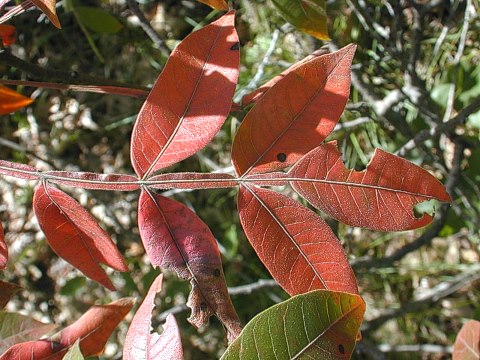Description: This woody shrub is up to 20' tall, but more often 5-6' tall. The new growth of the stems is usually covered with a greyish pubescence. The alternate compound leaves are oddly pinnate, individually consisting of 7-21 leaflets and a central leaf stalk that is conspicuously winged. These compound leaves are up to 2½' long. A leaflet is about 3" long and 1" across. It is ovate or ovate-lanceolate, with smooth margins and an upper surface that is glabrous or slightly pubescent. Some of the upper stems terminate in a panicle of flowers up to 1' long. This panicle is broader at the bottom than the top. The small flowers are yellowish white and individually about 1/8" (3 mm.) across. Each flower consists of 5 spreading petals, 5 stamens, and a central pistil. The calyx is divided into 5 triangular lobes that are recurved. Sometimes Winged Sumac is dioecious, with male and female plants. When this occurs, the flowers of the male plants will lack pistils, while the flowers of the female plants will lack stamens. The flowers usually bloom during mid-summer for about 2-3 weeks. Later in the year, they are replaced by dark red drupes that are covered with short acidic hairs. Each spheroid drupe is about 1/6" (4 mm.) long and contains a smooth stone. These drupes persist through the winter, gradually becoming black. The root system consists of a taproot and spreading rhizomes. Sometimes clonal colonies of plants are created by the rhizomes.

Cultivation: The preference is full or partial sun and mesic to slightly dry conditions. This plant often flourishes in poor soil that is sandy or rocky because of the reduced competition from other plants, but it should develop normally in richer soil as well. The foliage is normally attractive, but occasionally attacked by leaf spot and other kinds of foliar disease. This sumac is less aggressive than Rhus glabra (Smooth Sumac).
Range & Habitat: The native Winged Sumac is common in southern Illinois, occasional in NE Illinois, and rare or absent elsewhere (see Distribution Map). Habitats include openings in upland forests that are sandy or rocky, woodland borders, sandy savannas, sand prairies, limestone glades, fence rows, and abandoned fields. This is one of the shrubby invaders of sand prairies in NE Illinois. It prefers areas with a history of disturbance, such as fire.

Faunal Associations: The nectar and pollen of the flowers attract honeybees, bumblebees, leaf-cutting bees (Megachile spp.), little carpenter bees (Ceratina spp.), Halictid bees (including green metallic bees), plasterer bees (Colletes spp.), masked bees (Hylaeus spp.), Sphecid wasps, spider wasps (Pompilidae), Vespid wasps (paper wasps & others), Syrphid flies, Tachinid flies, flesh flies (Sarcophagidae), Calliphorid flies, Muscid flies, and ants (non-pollinating); see Robertson (1929), Wilhelm & Rericha (2017), and Grundel et al. (2011) for more information. Other insects feed destructively on Winged Sumac and other sumac shrubs (Rhus spp.). These insects include the wood-boring larvae of long-horned beetles, Sumac Flea Beetle (Blepharida rhois) and other leaf beetles, larvae of the Sumac Flowerbud Gall Midge (Asphondylia integrifoliae), Sumac Gall Aphid (Melaphis rhois) and other aphids, larvae of the Scarlet Sawfly (Arge coccinea), larvae of a butterfly, the Red-banded Hairstreak (Calycopis cecrops), and larvae of such moths as the Showy Emerald (Dichorda iridaria), Red-fronted Emerald (Nemoria rubrifrontaria), and Pygmy Paectes (Paectes pygmaea). The Insect Table provides a more complete list of these insects. Vertebrate animals also use sumac shrubs as sources of food. Many species of birds have been observed to feed on the fruits of these shrubs, particularly during the winter and spring when they are used as emergency food (see Bird Table). Examples of such birds include the Northern Cardinal, American Crow, Bobwhite Quail, Ruffed Grouse, Greater Prairie Chicken, European Starling, Hermit Thrush, Swainson's Thrush, Eastern Bluebird, American Robin, and Eastern Phoebe. Among mammals, the American Moose and White-tailed Deer browse on the foliage, twigs, and occasionally fruit, while the Cottontail Rabbit gnaws on the bark during the winter (Martin et al., 1951/1961; Sotala & Kirkpatrick, 1973; Myers et al., 2004). These shrubs also provide nesting habitat for birds, and protective cover for wildlife in general because of their tendency to form dense colonies.
Photographic Location: A sandy savanna at the Hooper Branch Savanna Nature Preserve in Iroquois County, Illinois.
Comments: The foliage turns red during the fall and is quite attractive. It is easy to identify this species in the wild because the central leaf stalks of the compound leaves are conspicuously winged (see the photo of the compound leaf). Another distinctive characteristic is the smooth margins of the leaves – other Rhus spp. have leaf margins that are serrate or crenate.